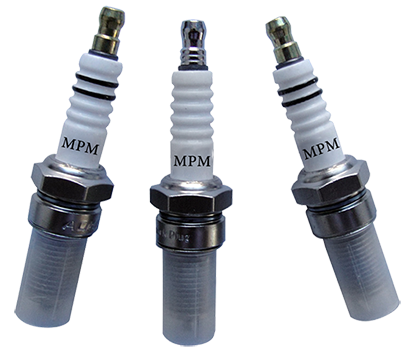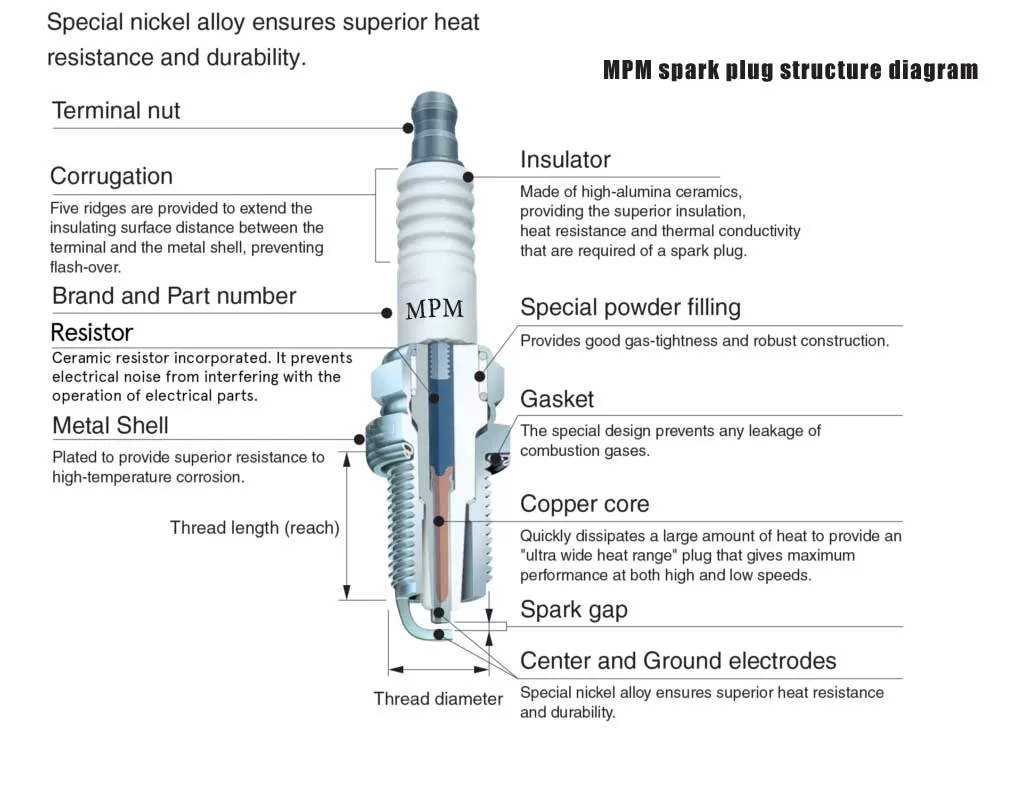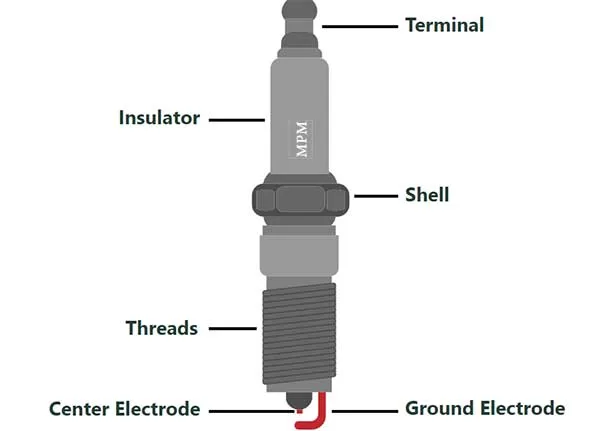Motorcycle Spark Plugs Manufacturer
MPM insists on manufacturing all spark plugs 100% in-house, whether installed as original accessories or offering factory-matching quality, we are committed to providing you with top performance racing and aftermarket products. For all motorcycle owners, no matter the model or purpose, you can expect the same world-class quality standards from us to ensure your riding experience is even better. When you choose MPM, you choose the double guarantee of excellent quality and reliable performance.

Features of Our Spark Plugs
- Higher Adaptability
meets various engine specifications and manufacturers’ demands.
- Reliable Starting
The spark plug ensures the starting even when the motor is cold.
- Optimum Engine Protection
Nickel-plated housing and thread protect against corrosion and seizure at the aluminum cylinder head.
- Higher Performance
Heat-shrink assembly ensures gas tightness and a steady heat range.
MPM Spark Plug Assembly & Function


- Terminal
This terminal connects the distributor cap from the ignition system to the center electrode.
- Insulator
The insulator insulates the terminals and connecting terminals from the shaft of the center electrode.
- Shell
Spark plugs typically have steel casings to allow for tightening and loosening of the plug and for heat transfer through the cylinder head.
- Threads
The threads, along with the housing, secure the spark plug in the cylinder head. Cover with insulation and provide support.
- Center Electrode & Ground Electrode
The center electrode is connected to the terminal through the center shaft. High voltage electricity is transmitted from the terminals through the shaft to the center electrode.
FAQ About Motorcycle Spark Plug
The best spark plug for a motorcycle depends on the specific make, model, and year of the motorcycle, as well as the rider’s preferences and the type of riding they do. Different spark plugs can affect the engine’s performance, fuel efficiency, and emissions.
Some factors to consider when choosing a spark plug for a motorcycle include:
Heat range: Spark plugs are rated by their heat range, which is determined by the amount of heat they can dissipate from the engine. The wrong heat range can cause premature wear, poor fuel economy, or engine misfiring. The manufacturer’s recommendation should be followed when selecting a spark plug heat range.
Material: Spark plugs are made from different materials, including copper, nickel, and iridium. Iridium spark plugs last longer and provide better performance than copper or nickel plugs, but they also cost more.
Gap size: The gap size refers to the distance between the center electrode and the ground electrode in the spark plug. The gap size can affect engine performance and fuel economy. The manufacturer’s recommended gap size should be followed.
Brand: There are many brands of spark plugs available, including OEM (original equipment manufacturer) spark plugs and aftermarket spark plugs. OEM spark plugs are typically recommended by the motorcycle manufacturer, while aftermarket spark plugs may offer improved performance or longer life.
Ultimately, the best spark plug for a motorcycle is the one that provides the best performance, fuel economy, and emissions while meeting the manufacturer’s recommendations. It is important to consult the owner’s manual or speak with a qualified motorcycle technician to determine the correct spark plug for a particular motorcycle.
The frequency of spark plug replacement on a motorcycle depends on several factors, including the type of spark plugs, the make and model of the motorcycle, and the riding conditions. However, as a general rule, most motorcycle manufacturers recommend replacing spark plugs every 5,000 to 10,000 miles (8,000 to 16,000 kilometers).
Some high-performance spark plugs, such as iridium plugs, may last longer and require replacement less frequently. The owner’s manual or the manufacturer’s recommendations should be consulted for specific information on spark plug replacement intervals for a particular motorcycle.
Additionally, it’s important to check the spark plugs regularly during routine maintenance to ensure they are in good condition. If the spark plugs are fouled, damaged, or have excessive wear, they should be replaced sooner.
Remember, spark plugs are a critical component of the engine and their condition can affect performance, fuel economy, and emissions. Regular replacement of spark plugs is an important part of maintaining the health and performance of your motorcycle.
There are several signs that can indicate that your motorcycle’s spark plugs may be bad or in need of replacement. Here are some common symptoms to watch for:
Engine Misfiring or Difficulty Starting: If your motorcycle is difficult to start or the engine misfires frequently, it could be a sign that the spark plugs are not producing enough spark to ignite the fuel mixture properly.
Poor Engine Performance: If your motorcycle’s engine lacks power, acceleration is sluggish, or the bike is running rough, it could be due to bad spark plugs.
Engine hesitation or Stalling: If the engine hesitates or stalls when accelerating or cruising, it could be a result of poor spark production by the spark plugs.
Black or Sooty Spark Plugs: If the spark plugs are covered in black soot or deposits, it indicates that the engine is running too rich (too much fuel) and the spark plugs are not burning off the excess fuel.
White or Glowing Spark Plugs: White or glowing spark plugs can indicate that the engine is running too lean (not enough fuel) and the spark plugs are overheating.
Visible Damage: If the spark plugs are visibly damaged, cracked, or have excessive wear on the electrodes, they should be replaced.
If you notice any of these symptoms, it’s a good idea to inspect the spark plugs. Carefully remove the spark plugs and visually inspect them. Use a spark plug gap tool to check the gap size, which should match the manufacturer’s recommendations. If the spark plugs look bad or if there is any doubt about their condition, it’s best to replace them with new ones.
Remember, spark plugs are a critical component of the engine and their condition can affect performance, fuel economy, and emissions. Regular replacement of spark plugs is an important part of maintaining the health and performance of your motorcycle.
No, not all motorbike spark plugs are the same. While there may be some similarities in the basic function and structure of spark plugs, there are differences in their design, materials, heat range, and other specifications that are tailored to specific motorcycles and engine requirements.
Different motorcycles and engines have different power outputs, compression ratios, and fuel systems, which require spark plugs with different characteristics. For example, some motorcycles may require a colder spark plug with a smaller heat range to prevent overheating, while others may need a hotter spark plug to ensure reliable ignition under high-load conditions.
Additionally, spark plugs are made from different materials, such as copper, nickel, platinum, or iridium. These materials affect the durability, performance, and cost of the spark plug. Platinum and iridium spark plugs, for example, are typically more durable and last longer than copper or nickel spark plugs.
Therefore, it’s important to use the correct spark plug that is recommended by the motorcycle manufacturer for your specific model and year. The owner’s manual or the service manual for your motorcycle will provide the correct part number and specifications for the spark plugs. Using the wrong spark plug can affect engine performance, fuel economy, and emissions, and may even cause damage to the engine.


